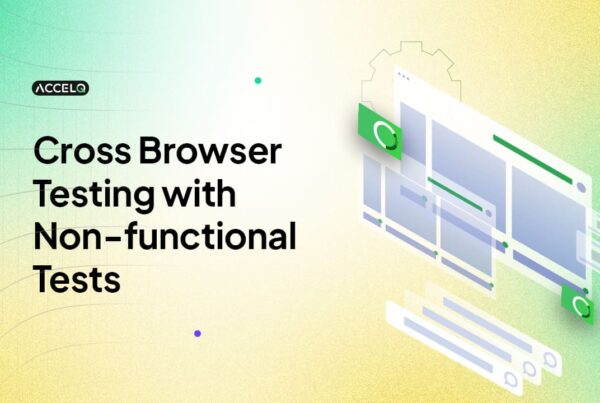An Overview of Cloud Testing: Types, Benefits, and Best Practices

The evolution of software testing in the era of cloud computing. Dedicated tools are not practical anymore since new applications are now developed and deployed over the cloud using SaaS, PaaS, and IaaS. This alternative has fueled a trend for cloud testing, a powerful strategy that confirms applications conform well in different real-world conditions.
In this blog, we are going to discuss what is cloud testing, the role of cloud automation testing, cloud testing types, and the benefits of cloud testing over traditional testing. We will also discuss how businesses can use cloud-based testing tools such as ACCELQ to perform seamless cloud software testing.
What is Cloud Testing?
Cloud Testing is the testing of applications over cloud-based resources. It emulates actual user scenarios, which means using test cloud computing to verify the software’s performance, scalability, and security. Testing in the cloud environment eliminates the limits of legacy infrastructure, offering scalable and on-demand solutions.
Cloud application testing is performed by organizations to ensure the reliability of their software on various devices, platforms, and network environments. Cloud testing enables organizations to enhance their apps for a smooth user experience in an inexpensive way without physical infrastructure investment.
Importance of Cloud Testing?
As companies increasingly embrace cloud platforms, ensuring applications run effectively in a cloud landscape is important. These solutions serve the purpose of real-time accessibility and allow testers to conduct automation scripts on a wide variety of browsers and operating systems over the cloud.
What Is Cloud Testing: Cloud testing is essential in cloud automation testing as it supports CI/CD pipelines and lets teams perform rapid, automated testing on simulated environments. This improves software quality further and shortens deployment cycles.
Types of Cloud Testing
Cloud testing is categorized based on various objectives and testing strategies. Below are some key types of cloud testing:
1. Performance Testing
- Evaluates application responsiveness, speed, and stability under varying loads.
- Identifies bottlenecks and optimizes performance for better scalability.
2. Load Testing
- Assesses how an application behaves under normal and peak load conditions.
- Ensures the system can handle expected user traffic without failures.
3. Stress Testing
- Determines the breaking point of an application by pushing it beyond its limits.
- Helps in understanding system recovery strategies under extreme conditions.
4. Security Testing
- Identifies vulnerabilities in cloud-hosted applications.
- Validates data protection mechanisms and compliance with security standards.
5. Compatibility Testing
- Ensures that applications work seamlessly across various devices, browsers, and operating systems.
- Verifies cross-platform functionality in a cloud web testing browser setup.
6. Functional Testing
- Checks if application features work as intended in a test cloud computing environment.
- Ensures seamless user experience across cloud-hosted applications.
7. Scalability Testing
- Determines how well an application scales up with increased workloads.
- Ensures that the application remains performant under high user demands.
8. Regression Testing
- Ensures that updates and modifications do not break existing functionality.
- Uses automation to accelerate the testing process in cloud environments.
Cloud Testing vs. Traditional Testing
Cloud testing differs from traditional software testing in multiple ways. Below is a comparison:
| Feature | Cloud Testing | Traditional Testing |
|---|---|---|
| Infrastructure | Uses cloud-based resources | Relies on in-house hardware |
| Scalability | Highly scalable and adaptable | Limited by physical resources |
| Cost Efficiency | Pay-per-use model, reduces cost | High infrastructure costs |
| Setup Time | Quick & flexible setup | Time-consuming & rigid |
| Accessibility | Remote testing from anywhere | Limited to physical location |
| Testing Speed | Faster CI/CD pipeline testing | Slower due to hardware constraints |
How to Perform Cloud Testing?
To successfully implement cloud software testing, follow these key steps:
1. Define Testing Requirements
- Identify the scope of testing: performance, security, compatibility, or functional testing.
- Define testing objectives and expected outcomes.
2. Select a Cloud Provider
- Choose a test cloud computing service that aligns with your testing needs.
- Consider factors like scalability, security, and pricing.
3. Configure the Testing Environment
- Set up cloud application testing environments to mimic real-world scenarios.
- Ensure access to diverse devices, browsers, and OS platforms.
4. Leverage Automation Tools
- Use cloud automation testing frameworks to streamline test execution.
- Implement continuous testing in CI/CD workflows.
5. Execute Tests
- Perform different types of cloud testing based on application needs.
- Simulate various user conditions and workloads.
6. Monitor and Analyze Results
- Track test performance in real time.
- Identify and fix issues promptly to optimize application quality.
Benefits of Cloud Testing
Adopting cloud software testing offers multiple advantages, including:
- Cost Savings: Reduces infrastructure investment with a pay-per-use model.
- Faster Time-to-Market: Enables rapid development and deployment cycles.
- Scalability: Supports flexible resource allocation based on test requirements.
- Global Accessibility: Allows testing from anywhere, ensuring team collaboration.
- Better Test Coverage: Supports cross-browser and cross-device compatibility testing.
Challenges of Cloud Testing
While there are numerous benefits, cloud testing has certain challenges:
- Data Security Issues: User data could be vulnerable to various types of attacks during the process of cloud testing.
- Integration Challenges: Integration of cloud services with existing tools and systems may be tricky.
- Network Dependency: As cloud testing is harried over the internet, it may cause latency issues.
- Limited Control: Testing in the cloud offers less control over the environment than in-house setups.
Conclusion
In conclusion, cloud testing is an important practice in modern-day software development, providing companies with the ability to produce fast, stable, and secure applications. Cloud automation testing enables organizations to streamline their release cycles, cut costs, and improve test coverage.
Platforms such as ACCELQ enable organizations to weave cloud testing into their development fabric, ensuring that all their applications are solid, safe, and high-performing under real-world conditions. With cloud adoption on the rise, investing in cloud software testing has become a certitude for succeeding in the digital era.
Prashanth Punnam
Sr. Technical Content Writer
With over 8 years of experience transforming complex technical concepts into engaging and accessible content. Skilled in creating high-impact articles, user manuals, whitepapers, and case studies, he builds brand authority and captivates diverse audiences while ensuring technical accuracy and clarity.
You Might Also Like:
 Regression Testing: The Ultimate Guide with Examples
Regression Testing: The Ultimate Guide with Examples
Regression Testing: The Ultimate Guide with Examples
 Cross Browser Testing with Non-functional Tests
Cross Browser Testing with Non-functional Tests
Cross Browser Testing with Non-functional Tests
 Functional vs Non-Functional Testing in Software Testing: Why Both Matter
Functional vs Non-Functional Testing in Software Testing: Why Both Matter
































